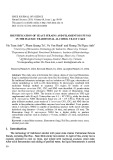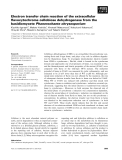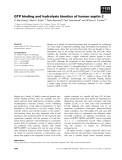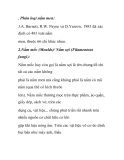
Filamentous fungi
-
This study aims to determine the various strains of yeast and filamentous fungi in traditional alcohol yeast cake from Hai Hau district, Nam Dinh province. By traditional laboratory techniques such as isolation on YPD agar, observation of colony morphology as well as cell characteristics by microscopy, combined with molecular biology method to sequence ITS region 03 strains of yeast Saccharomyces cerevisiae CN1, CN2, and NM3 were identified: 01 pseudo-strain yeast Saccharomycopsis fibuligera NM02 and 01 strain of filamentous fungi Rhizopus microsporus NS04.
 10p
10p  viaburame
viaburame
 14-03-2025
14-03-2025
 0
0
 0
0
 Download
Download
-
To elucidate the structural features of the mussel defensin MGD1 required for antimicrobial activity, we synthesized a series of peptides corresponding to the main known secon-dary structures of the molecule and evaluated their activity towards Gram-positive and Gram-negative bacteria, and filamentous fungi. We found that the nonapeptide corres-ponding to residues 25–33 of MGD1 (CGGWHRLRC) exhibited bacteriostatic activity once it was cyclized by a non-naturally occurring disulfide bridge.
 9p
9p  fptmusic
fptmusic
 16-04-2013
16-04-2013
 50
50
 2
2
 Download
Download
-
Cellobiose dehydrogenase (CDH) is an extracellular flavocytochrome con-taining flavin and b-type heme, and plays a key role in cellulose degrada-tion by filamentous fungi. To investigate intermolecular electron transfer from CDH to cytochrome c, Phe166, which is located in the cytochrome domain and approaches one of propionates of heme, was mutated to Tyr, and the thermodynamic and kinetic properties of the mutant (F166Y) were compared with those of the wild-type (WT) enzyme.
 0p
0p  awards
awards
 06-04-2013
06-04-2013
 36
36
 2
2
 Download
Download
-
Septins are a family of conserved proteins that are essential for cytokinesis in a wide range of organisms including fungi, Drosophila and mammals. In budding yeast, where they were first discovered, they are thought to form a filamentous ring at the bridge between the mother and bud cells.
 13p
13p  inspiron33
inspiron33
 25-03-2013
25-03-2013
 49
49
 4
4
 Download
Download
-
J.A. Barnett, R.W. Payne và D.Yarrow, 1983 đã xác định có 483 loài nấm men, thuộc 66 chi khác nhau. 2.Nấm mốc (Moulds)/ Nấm sợi (Filamentous fungi): Nấm mốc hay còn gọi là nấm sợi là tên chung để chỉ tất cả các nấm không phải là nấm men mà cũng không phải là nấm có mũ nấm (quả thể có kích thước lớn). Nấm mốc thường mọc trên thực phẩm, áo quần, giầy dép, sách vở, trên các dụng cụ, vật liệu... chúng phát triển rất nhanh trên nhiều nguồn cơ chất hữu cơ khi gặp khí hậu nóng...
 2p
2p  pencil_6
pencil_6
 12-10-2011
12-10-2011
 102
102
 10
10
 Download
Download
CHỦ ĐỀ BẠN MUỐN TÌM

















